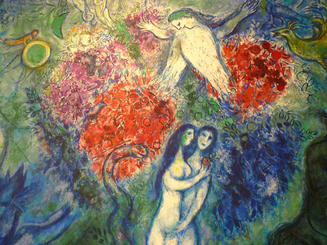

Tenth Sunday of Ordinary Time, year B, June 9, 2024
Among the purposes of the authors of Genesis were to explain the causes of human shame and sin, to assert the sovereignty of the one God over all creation, and to express the superiority of the worship of that God over rival religions. All those goals are part of this fragment of the creation story, the aftermath of Eve and Adam's deception by the serpent.
Saint Paul suffered unfair criticism from the Christians of Corinth, and endured much weakening in his labors as an apostle. But here he defiantly asserts that it is all part of God's plan revealed in Christ, and he looks forward to a glorious future for both his critics and himself.
This gospel preserves memories of several ways Jesus was misunderstood and misrepresented. The writer wanted his readers to have a complete picture of the One they were trying to follow.
The Past of this Passage: Historically, this has elements of an early explanation of the very common human fear of snakes. Theologically, it reminds us of the early rivalry between worshipers of Yahweh and worshipers of Baal. The cult of Baal included sacred prostitution as a fertility rite, of which the serpent was an apt symbol (an asp, perhaps?). So the shame that the couple feels over having been deceived by the representative of Baal is a caution to Yahweh's faithful: Don't mess with the religion of Baal or you will be shamed. And we know even today how strenuously the people of the Middle East try to avoid shame. In the Bible passage, Yahweh's creatures lose a battle, but Yahweh wins the war, condemning the snake (and its worshipers) to a life of disdain and depredation by humans.
The Provenance of the Prior Paragraph: I borrow the above interpretation, loosely, from John J. Pilch, who died in 2016 after a distinguished teaching career that reached its summit at Georgetown University in Washington, D.C., of the United States. Doctor Pilch, in turn, relies on the Polish Jesuit biblical scholar Julian Sulowski. For an interesting take on Israelite disgust with Baal worship's sacred prostitution, I strongly recommend Thomas Cahill's book The Gifts of the Jews. As I recall from reading it several years ago, the introduction is an imaginative description of a pagan orgiastic ritual. The excesses of the rite make a certain Chaldean question his "religion" and everything associated with it. Something in his heart tells him to leave it all and start a new life, honoring a new God, in a new land. That pilgrim got a new name, too, "Abraham." Fertility would continue to be an issue for him and his wife, but their new God would take care of that.
Your Proclamation: The titillating business of Baal worship aside, this passage asserts the authority of the One God, who is the main speaker in this conversation (notice that the snake doesn't even get a word in). So speak God's words with authority, slowly, perhaps with low, dark tones. When you pronounce the silly excuses offered by the man and the woman, make them sound afraid and utterly without confidence.
Our Liturgical Situation: It is Ordinary Time again, or the season "Sundays of the Year." So we return to the sequence of second readings from the Second Letter to the Corinthians, gospel readings from Mark, and first readings chosen from the Hebrew Scriptures for how they might relate to the gospel passage. The last ordinary Sunday we observed before Lent, 2024, was the Sixth Sunday of that non-season. (Seventh, Eighth and probably Ninth Sundays are squeezed out of the calendar this year.)
The Historical Situation of Paul and Corinth: Saint Paul had a rocky relationship with the Christians of Corinth. He had first come to them after an embarrassing debacle in Athens (see Acts 17 and Acts 18. There he had changed his tactics, relying not on his human eloquence but on the power of God working through him. The results were a flourishing Christian community. Paul left for other mission venues. The community was so flourishing that it got rather wild, and Paul wrote his first letter to them to correct some abuses. He promised another visit, but changed his plans. This earned him serious criticism and ridicule from some Corinthians, so his second letter to them is somewhat defensive. He asserts his authority as an apostle (always in issue, given his late conversion), and seizes their criticism of his inconsistency to write a magnificent salute to the fidelity of God.
Today's paragraphs, then, come from reflection on his suffering and weakened condition, and the exciting if unruly history of the community in Corinth, all viewed in the light of Christ''s resurrection power, which all parties share. If this were a speech, Paul would sound defiant: "I may look like I'm in decay, but I spoke what I believed, and I fully expect vindication at the side of the Risen Christ. And everything I did, including the things you misinterpret, was for your good. And God has been glorified in all this."
Your Proclamation: Knowing that background, using Paul's words, give that speech. In the translation offered us (in the U.S.A), the English sentences are long. (Supplying punctuation when translating ancient texts is an inexact science.) So to make it sound emphatic and impassioned, you'll have to break it up a bit. You can pause at commas, and change your tone of voice from one clause to the next. Make it sound as interesting as Paul himself and the community at Corinth were.
Chagall, Marc, 1887-1985. Adam and Eve, from Art in the Christian Tradition, a project of the Vanderbilt Divinity Library, Nashville, TN. https://diglib.library.vanderbilt.edu/act-imagelink.pl?RC=54653 [retrieved April 9, 2018]. Original source: https://www.flickr.com/photos/abeppu/3816721814/.
Some sources online say the original painting is in the Musée National Marc Chagall, Nice, France.
This page updated June 6, 2024